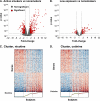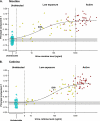Threshold of biologic responses of the small airway epithelium to low levels of tobacco smoke
- PMID: 20693378
- PMCID: PMC3029938
- DOI: 10.1164/rccm.201002-0294OC
Threshold of biologic responses of the small airway epithelium to low levels of tobacco smoke
Abstract
Rationale: Epidemiologic data demonstrate that individuals exposed to low levels of tobacco smoke have decrements in lung function and higher risk for lung disease compared with unexposed individuals. Although this risk is small, low-level tobacco smoke exposure is so widespread, it is a significant public health concern.
Objectives: To identify biologic correlates of this risk we hypothesized that, compared with unexposed individuals, individuals exposed to low levels of tobacco smoke have biologic changes in the small airway epithelium, the site of the first abnormalities associated with smoking.
Methods: Small airway epithelium was obtained by bronchoscopy from 121 individuals; microarrays were used to assess genome-wide gene expression; urine nicotine and cotinine were used to categorize subjects as "nonsmokers," "active smokers," and "low exposure." Gene expression data were used to determine the threshold and induction half maximal level (ID₅₀) of urine nicotine and cotinine at which the small airway epithelium showed abnormal responses.
Measurements and main results: There was no threshold of urine nicotine without a small airway epithelial response, and only slightly above detectable urine cotinine threshold with a small airway epithelium response. The ID₅₀ for nicotine was 25 ng/ml and for cotinine it was 104 ng/ml.
Conclusions: The small airway epithelium detects and responds to low levels of tobacco smoke with transcriptome modifications. This provides biologic correlates of epidemiologic studies linking low-level tobacco smoke exposure to lung health risk, identifies the genes most sensitive to tobacco smoke, and defines thresholds at which the lung epithelium responds to low levels of tobacco smoke.
Figures



References
-
- Jaakkola MS, Jaakkola JJ. Effects of environmental tobacco smoke on the respiratory health of adults. Scand J Work Environ Health 2002;28:52–70. - PubMed
-
- Chan-Yeung M, Dimich-Ward H. Respiratory health effects of exposure to environmental tobacco smoke. Respirology 2003;8:131–139. - PubMed
-
- Janson C. The effect of passive smoking on respiratory health in children and adults. Int J Tuberc Lung Dis 2004;8:510–516. - PubMed
-
- 2004 Surgeon General's Report—The Health Consequences of Smoking (accessed October 19, 2010). Available from: http://www.cdc.gov/tobacco/data_statistics/sgr/2004/index.htm. 2004.
-
- Eisner MD, Wang Y, Haight TJ, Balmes J, Hammond SK, Tager IB. Secondhand smoke exposure, pulmonary function, and cardiovascular mortality. Ann Epidemiol 2007;17:364–373. - PubMed
Publication types
MeSH terms
Substances
Grants and funding
LinkOut - more resources
Full Text Sources
Other Literature Sources
Medical
Molecular Biology Databases

